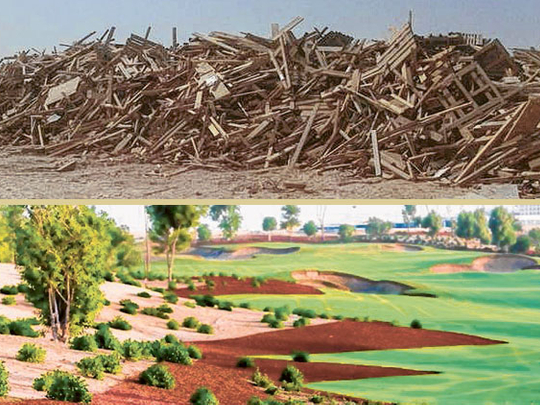
Abu Dhabi: Timber waste from construction activities which used to end up in landfills is now being used to create beautiful landscapes in Masdar City in Abu Dhabi, the world's first zero-carbon city.
The process also saves a lot of water and money as it helps to reduce irrigation evaporation and minimises overall horticultural costs in the city.
Waste timber is utilised in a number of ways across the city, including being converted into mulch for landscaping, a senior official of Masdar, Abu Dhabi Future Energy Company, told Gulf News.
All landscaping within the city, including Masdar's site offices, has benefitted from this technique, said Dr Nawal Al Hosani, associate director, Sustainability at Masdar.
Masdar City is designed to be a low waste, low carbon city and wherever possible waste timber is reused to minimise the amount of waste sent to landfills.
Since the Material Recycling Centre was opened at Masdar City, more than 6,500 tonnes of timber have been diverted from landfill, the official said.
Most of that timber waste [6,500 tonnes] has been used around and outside Masdar city, and the rest will be used as required, Dr Nawal said.
All the construction waste timber is expected to be chipped and reused in this way.
Sustainability can offer significant economic benefits in addition to environmental advantages.
Masdar City has a target rate of approximately six litres of water per square metre per day for public realm landscaping, which is approximately one third of the water normally required for it, Dr Nawal said.
This will be achieved by maximising the use of native plants which require less water than imported species and clever urban planning and design, thus resulting in lower water costs, she explained.
Masdar also works closely with contractors to ensure best practices are followed when it comes to sustainability, the official said.
For example, the use of ‘formwork' timber at the construction site has been increased several times thanks to the better practices, Dr Nawal said.
Formwork is the term given to either temporary or permanent molds into which concrete or similar materials are poured.
Formwork timber at the Masdar construction site was previously used an average of only 10 times.
However, after better handling procedures and an education campaign were implemented, it is now used an average of 25 times, maximising the reuse, the official said.
Abu Dhabi Masdar City solid waste management strategy seeks to minimise waste in landfills and maximise the resource potential of waste by recycling, composting and recovering energy.
For phase one, total waste is expected to be around 22,000 tonnes a year, and the phase one target is to divert 50 per cent of all waste from landfills.
The city's solid waste is divided into three principle streams: dry recyclables such as cans, plastics, cardboard, paper, etc; wet recyclables such as food and other organic waste, and residuals such as toothpaste tubes, empty food containers and other common waste that is not clearly one of the other two.
A fourth stream, which represents a small percentage of the total, includes bulky waste, hazardous wastes and other special wastes such as batteries.
Buildings in the city have three waste chutes to allow for easy separation into the three main waste streams.
A Resource Recovery Centre (RRC) in Masdar City will have facilities to further sort dry recyclables before onward transport to local or regional reprocessing facilities, compost wet recyclables for use in city landscaping, and prepare the remaining non-recyclable and special waste for offsite management.
Arabic tradition to help sustainability
Masdar City's master plan design combines the century-old learning of traditional Arabic urban planning and architecture with leading edge technologies to create a sustainable, high-quality living environment for all residents. The city will be built in seven carefully designed phases, incorporating the latest technological advances generated in its clean-tech cluster and globally.
The passive design element incorporated into the master plan is of vital importance. Low-rise, high-density neighbourhoods increase shading which reduces dependency on energy systems. The city's northeast and southwest maximises cool breezes flowing from the Gulf during the day and the cool air flowing from the desert at night. Natural wind towers and day shading on roofs are incorporated into the design.












